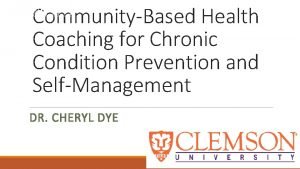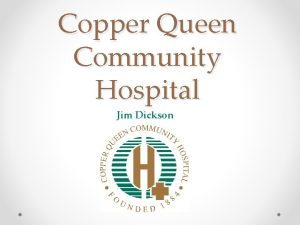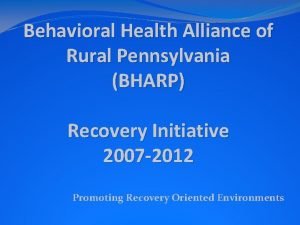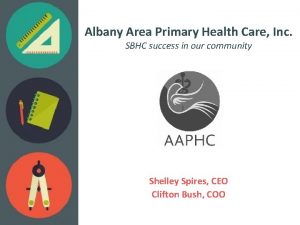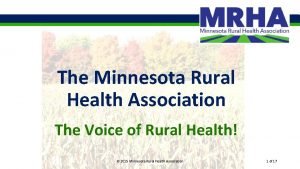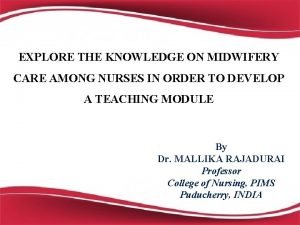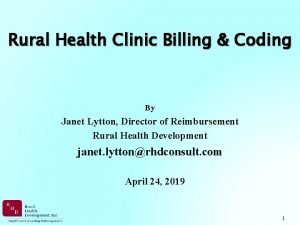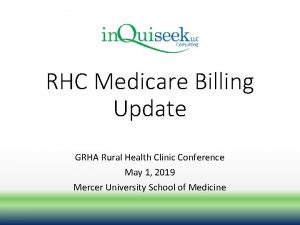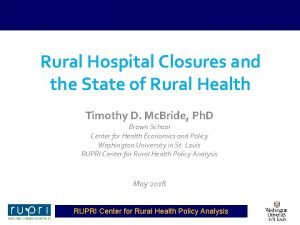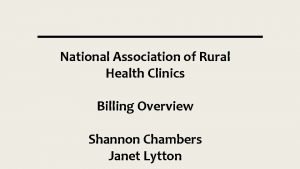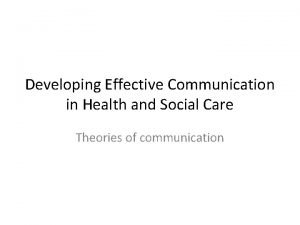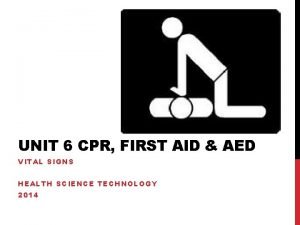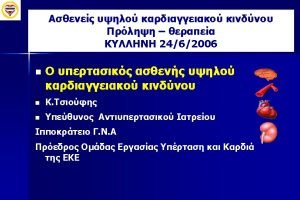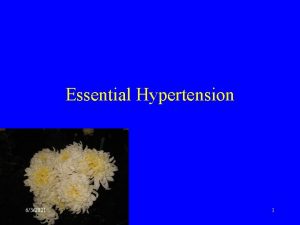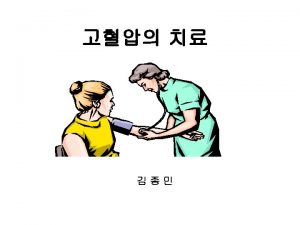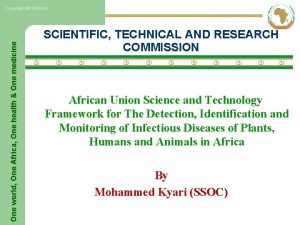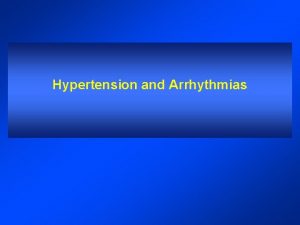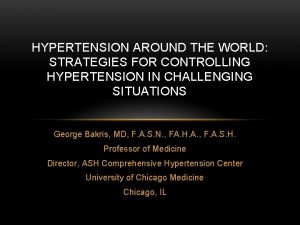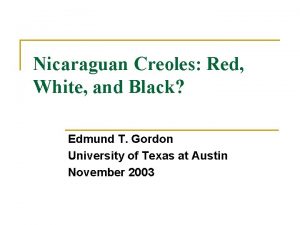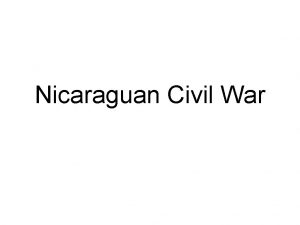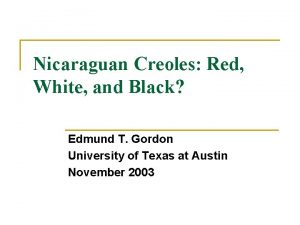Hypertension in a One World Health Rural Nicaraguan



























- Slides: 27

Hypertension in a One. World Health Rural Nicaraguan Ambulatory Clinic: Prevalence and Management Jennifer Lee, DO

Objectives • Introduction to CDC/PAHO Global Standardized Hypertension Treatment Project • Discuss findings from the initial assessment of El Viejo • Discuss challenges of research in a developing country • Discuss future research questions 2

CDC/PAHO Global Standardized Hypertension Treatment • Launched in 2011 • Implemented in some Latin American and Caribbean regions • Goals: – Identify barriers to treatment – Standardize care – Improve delivery systems 3

Nicaragua • Limited research on hypertension – Prevalence – Management/Quality – Barriers to care • Access • Cost • Education • Population: 6 million - Life expectancy: 73 • Top causes of death: - Ischemic heart disease (15. 5%) - Stroke (9. 2%) - Kidney disease (7. 1%) - Diabetes mellitus (5. 7%) *Country statistics by WHO and UN partners 4

METHODS 5

Methods • Cross sectional study • Based on 349 ambulatory care patient charts from a single clinic in El Viejo, Nicaragua, and interviews of clinic staff • Created an abstract form to capture data from medical records: – – – 6 patient demographics area of population served reasons for seeking care prevalence of hypertension and prescribing practices and local cultural beliefs.

Methods • Data gathering – Challenges: • • • 7 Foreign language Paper charts/illegibility Incomplete charting No postal address Limited resource setting

Methods • Data Analysis – Epidata – software used for data entry • Data from the instrument entered into Epidata – SAS 9. 4 – statistical analysis program • Basic analysis of the data to present a descriptive analysis of the data collected 8

Questions to Answer from the data: • • • What is the prevalence of hypertension in this population? Who comes to the clinic (age, gender)? What area does the clinic serve? What hypertension medications are being prescribed? Do medications prescribed differ from the national registry? Does the data support the notion that chronic disease is a problem in Nicaragua? • Does the data reflect the beliefs/practices of the people? 9

RESULTS 10

Demographics - Gender Male Female Male 33% Female 67% 11 Males - (114) Females - (231)

AGE • MEAN = 44. 2 Years (SD = 17. 53) • MEDIAN = 44 Years • RANGE = 18 – 92 Years old

Population Served El Viejo = 1 km Neighborhoods: 23% - Light Blue 10% - Pink 10% - Dark Blue 9% - Gray 8% - Green 4% - Yellow Total: 64% within El Viejo and within 3 km of clinic (1. 8 miles) 13 1 km ★

Diseases Top Ten Diagnoses 12. 00% % Disease Diagnosed 10. 00% 1 – UTI 2 – Hypertension 3 – Hyperlipidemia 4 – Anemia 5 – Low Back Pain 6 – Constipation 7 – Hepatic Steatosis 8 – Bronchitis 9 – Diabetes Mellitus Type 2 10 – Acute diarrhea 8. 00% 6. 00% 4. 00% 2. 00% 0. 00% 1 2 3 4 5 6 Diagnosis 14 7 8 9 10

Prevalence of Diagnoses by Systems 25% 1 -Gastrointestinal 2 -Genitourinary 3 -Endocrine/metabolic 4 -Cardiovascular 5 -Musculoskeletal 6 -OB/Gyn 7 -Renal 8 -Respiratory 9 -Other 10 -ENT 11 -Psychiatric 12 -Skin/Derm 13 -Neurologic 14 -Blood/Lymph Percent Diagnosed 20% 15% 10% 5% 0% Series 1 15 1 19% 2 14% 3 11% 4 10% 5 8% 6 6% 7 6% 8 5% 9 5% 10 4% 11 3% 12 3% 13 3% 14 2%

BLOOD PRESSURE (Entire Sample = 349) Less than 140/90 or Higher 19% 81%

Hypertension at 60 and older BP < 150/90 – (53) BP > 150/90 – (20) *note that only 7% of the population of Nicaragua is >60 17

Follow up? Yes - (150) No – (189) 18

Top Ten Medications Prescribed 35 Number of times prescribed (n=349) 30 25 1 – Omeprazole 2 – Levofloxacin 3 – Ibuprofen 4 – Novalgina 5 – Intrafer (iron) 6 – Ketorolac 7 – Meneparol 8 – Ciprofloxacin 9 – Cefixime 10 – Omega 3 20 15 10 5 / 1 19 2 3 4 5 6 Medications 7 8 9 10

Medication on National Formulary • Diuretics – HCTZ + Amiloride • ACE Inhibitors – Enalapril – Captopril 20 • ARBs - Losartan • Calcium Channel Blockers - Amlodipine - Nifedipine - Atenolol

Outreach Survey Results (Sebaco) 21

Outreach Survey Results (Sebaco) 22

Study Weaknesses • Limited information due to sparse/incomplete charting – Limited data about patient compliance and past medical history • Visiting non-Nicaraguan doctors may have skewed results • Reliance upon local population for determination of patient residence 23

Study Strengths • Sample size (349 charts) • Identified areas of incomplete or non-existent documentation • Incorporation of cultural beliefs in interpretation of significance and meaning of data outcomes 24

Conclusions • Hypertension is one of the most common diagnoses given at the El Viejo clinic • Improved documentation could provide insight into specific risk factors, trends, and compliance • There is a need for private clinics and pharmacies that provide affordable care and medications • Convenience, reliability, and the patient’s perception of the integrity of provider and medication influence adherence 25

Future Questions • Will an intervention program based of of the CDC/PAHO framework for El Viejo? • Will strengthening the physician-pharmacist-patient relationship improve compliance? • Will the intervention create more accurate and robust documentation? • Why are broad-spectrum antibiotics being used? • How are prescribing habits influenced by the patient’s expectation in the private clinic setting? 26

References • CDC/PAHO • Formulario Nacional de Medicamentos 7 th Edición 2014 27
 According to the nicaraguan poet daisy zamora poetry is
According to the nicaraguan poet daisy zamora poetry is Health coaches for hypertension control
Health coaches for hypertension control Bisbee rhc
Bisbee rhc Bharp
Bharp Albany area primary health care dental
Albany area primary health care dental Mn rural health conference
Mn rural health conference Rural health care
Rural health care National rural health mission
National rural health mission Rural health clinic coding
Rural health clinic coding Medicare rural health clinic billing
Medicare rural health clinic billing Tonapah, nv
Tonapah, nv Revenue code 0521
Revenue code 0521 Health promotion and maintenance
Health promotion and maintenance Through one man sin entered
Through one man sin entered Michael argyle communication cycle health and social care
Michael argyle communication cycle health and social care One god one empire one emperor
One god one empire one emperor One one little dog run
One one little dog run One king one law one faith
One king one law one faith Byzantine definition
Byzantine definition Ford one plan
Ford one plan See one do one teach one
See one do one teach one See one, do one, teach one
See one, do one, teach one Night structure
Night structure Studiendekanat uni bonn
Studiendekanat uni bonn One vision one identity one community
One vision one identity one community Asean one vision one identity one community
Asean one vision one identity one community Hypertension artérielle
Hypertension artérielle Vital signs cpr
Vital signs cpr

